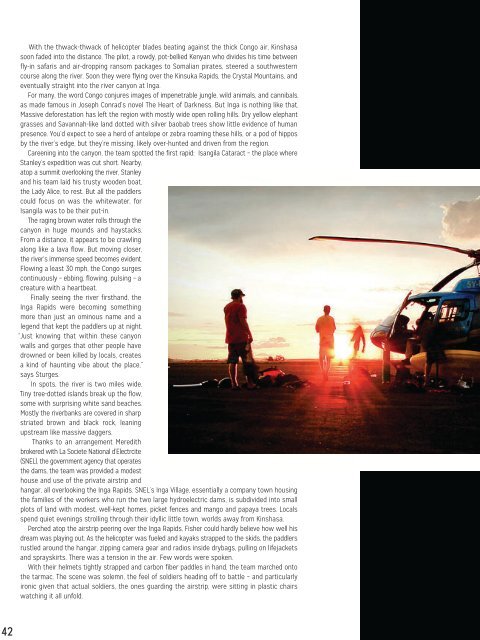River Karma
Typography project: Curated a typographic system that can be applied to various issues and structural spreads successfully where content influences the overall style and reading experience. Self created concept that focuses on grid and typographic hierarchy development pulling all articles and photographic sources from existing publications.
Typography project: Curated a typographic system that can be applied to various issues and structural spreads successfully where content influences the overall style and reading experience. Self created concept that focuses on grid and typographic hierarchy development pulling all articles and photographic sources from existing publications.
You also want an ePaper? Increase the reach of your titles
YUMPU automatically turns print PDFs into web optimized ePapers that Google loves.
42<br />
With the thwack-thwack of helicopter blades beating against the thick Congo air, Kinshasa<br />
soon faded into the distance. The pilot, a rowdy, pot-bellied Kenyan who divides his time between<br />
fly-in safaris and air-dropping ransom packages to Somalian pirates, steered a southwestern<br />
course along the river. Soon they were flying over the Kinsuka Rapids, the Crystal Mountains, and<br />
eventually straight into the river canyon at Inga.<br />
For many, the word Congo conjures images of impenetrable jungle, wild animals, and cannibals,<br />
as made famous in Joseph Conrad’s novel The Heart of Darkness. But Inga is nothing like that.<br />
Massive deforestation has left the region with mostly wide open rolling hills. Dry yellow elephant<br />
grasses and Savannah-like land dotted with silver baobab trees show little evidence of human<br />
presence. You’d expect to see a herd of antelope or zebra roaming these hills, or a pod of hippos<br />
by the river’s edge, but they’re missing, likely over-hunted and driven from the region.<br />
Careening into the canyon, the team spotted the first rapid: Isangila Cataract – the place where<br />
Stanley’s expedition was cut short. Nearby,<br />
atop a summit overlooking the river, Stanley<br />
and his team laid his trusty wooden boat,<br />
the Lady Alice, to rest. But all the paddlers<br />
could focus on was the whitewater, for<br />
Isangila was to be their put-in.<br />
The raging brown water rolls through the<br />
canyon in huge mounds and haystacks.<br />
From a distance, it appears to be crawling<br />
along like a lava flow. But moving closer,<br />
the river’s immense speed becomes evident.<br />
Flowing a least 30 mph, the Congo surges<br />
continuously – ebbing, flowing, pulsing – a<br />
creature with a heartbeat.<br />
Finally seeing the river firsthand, the<br />
Inga Rapids were becoming something<br />
more than just an ominous name and a<br />
legend that kept the paddlers up at night.<br />
“Just knowing that within these canyon<br />
walls and gorges that other people have<br />
drowned or been killed by locals, creates<br />
a kind of haunting vibe about the place,”<br />
says Sturges.<br />
In spots, the river is two miles wide.<br />
Tiny tree-dotted islands break up the flow,<br />
some with surprising white sand beaches.<br />
Mostly the riverbanks are covered in sharp<br />
striated brown and black rock, leaning<br />
upstream like massive daggers.<br />
Thanks to an arrangement Meredith<br />
brokered with La Societe National d’Electrcite<br />
(SNEL), the government agency that operates<br />
the dams, the team was provided a modest<br />
house and use of the private airstrip and<br />
hangar, all overlooking the Inga Rapids. SNEL’s Inga Village, essentially a company town housing<br />
the families of the workers who run the two large hydroelectric dams, is subdivided into small<br />
plots of land with modest, well-kept homes, picket fences and mango and papaya trees. Locals<br />
spend quiet evenings strolling through their idyllic little town, worlds away from Kinshasa.<br />
Perched atop the airstrip peering over the Inga Rapids, Fisher could hardly believe how well his<br />
dream was playing out. As the helicopter was fueled and kayaks strapped to the skids, the paddlers<br />
rustled around the hangar, zipping camera gear and radios inside drybags, pulling on lifejackets<br />
and sprayskirts. There was a tension in the air. Few words were spoken.<br />
With their helmets tightly strapped and carbon fiber paddles in hand, the team marched onto<br />
the tarmac. The scene was solemn, the feel of soldiers heading off to battle – and particularly<br />
ironic given that actual soldiers, the ones guarding the airstrip, were sitting in plastic chairs<br />
watching it all unfold.


